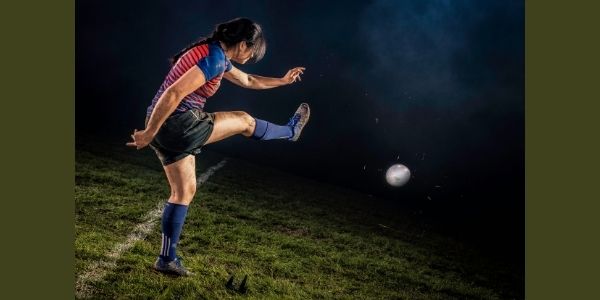This article looks at the position and role of the fly-half in sevens rugby. The fly-half may also be called the outhalf or the standoff.
I’ve got some great video clips to illustrate some of the skills of fly-halves in sevens rugby.
What Is A Flyhalf In Rugby Sevens?
Flyhalves in sevens rugby are one of the two playmakers on the field for a team, along with the scrumhalf. They work together to direct the attacking play.
The flyhalf usually takes the kicks to restart the game and for lineout position from penalties. They need speed and great passing skills.
Playmakers call the attacking moves on the field and use their passing skills to direct the flow.
The goal is to put their team into situations where they have more attackers in an area on the field than the opposition has defenders.
The center of the field is usually the best place to direct the attack. The flyhalf usually takes a central position on the field during scrums and lineouts to receive the ball from the scrum-half.
We have a separate article on scrumhalves in sevens rugby. Many players switch between the positions with ease.
Flyhalves Do Most Of The Kicking In Rugby Sevens

Most positions on a sevens rugby team require more focus on passing and running skills than on kicking. The exception is the flyhalf position.
Flyhalves are often the best kickers on the team and must spend time on kicking drills. Their kicking skills are required for:
- Taking the restarts after a score
- Kicking the conversion after a try is scored
- Kicking penalties to the touchline for lineouts
- Kicking penalties for goal
Kicking for goal in sevens rugby is a specialist skill. Unlike the fifteen-a-side code where conversions and penalties are taking from the ground, kicks for goal in sevens rugby are taken as a drop-kick. This is probably a harder skill to master!
Penalties in sevens rugby are often tapped quickly to continue with open play. However, teams may opt to kick the ball out of play to secure the lineout. The kicker tries to get the ball as far into opposition territory as possible. This is one skill that transfers directly across from fifteens rugby.
Restarts deserve their own section. Read on…
Kicking Restarts

The restart is hugely important in sevens rugby and is a major part of team tactics. The aim is to kick high to a particular position on the field.
When the ball is in the air for long enough, the kicker’s teammates have a chance to reach the spot where the ball would land. The results can be spectacular.
This video clip is an example of perfect timing and outstanding skill on the part of several players on the USA Sevens team. This was versus Scotland at the New Zealand Hamilton tournament in 2019.
The flyhalf gets perfect height and position on the ball. His forward makes a clean catch and passes to the center who scores a try – straight from kickoff!
Another technique is to kick a little longer into opposition territory. The aim is to kick the ball so high in the air that a chaser can make an immediate tackle on the opposing player who catches the ball.
The kicker’s other teammates have time to fan out in a strong defensive line. This video shows the technique put to good effect.
Fly-#halves And Lineouts
If you watch the fifteen-a-side version of Rugby Union, then you’ll be very familiar with a particular lineout play: a forward jumps to catch the ball and drops it to the scrum-half who fires it out to the flyhalf.
The big difference in sevens rugby is that you’ll see flyhalves throwing the ball into the lineout. You’ll also see them running back onto the pitch to receive the ball from the forward.
Take a look at some examples:
Flyhalves And Passing Skills
Flyhalves are key to launching attacks through long or short passes, so their passing skills must be excellent.
Probably more so than their equivalents in fifteens, the sevens flyhalf must be able to execute long accurate passes.
The opposition are always looking to pick off an interception, so these passes must travel as fast as possible through the air.
This means that the spin pass is more common.
But you’ll also see shorter pop passes, reverse passes, and many other variations. Check out our article on the different types of passing in rugby. We count eleven!
Can Flyhalves Move From Fifteens Rugby To Sevens?
The flyhalf position in fifteens rugby places great emphasis on kicking and passing skills.
Flyhalves in fifteens are usually the primary playmaker on the team (although that role is often taken by scrumhalves in France and South Africa).
These attributes make it easier for flyhalves to switch between fifteens and sevens rugby.
What Number Does A Flyhalf Wear In Sevens?
You may know that the starting flyhalf in fifteen-a-side matches wears the number ten.
In contrast, the numbers in sevens rugby are not tied to a position on the field. So you’ll see the ten shirt being worn by all kinds of positions.
The flyhalf may wear any number between one and twelve.
Do We Say Flyhalf Or Outhalf Or Standoff in Sevens?
You’ll see this position called flyhalf, outhalf or standoff in different parts of the world.
Just don’t refer to the position as “the ten” in sevens as is often done in fifteen-a-side rugby. As I’ve just explained, shirt numbers in the sevens game do not define a position.